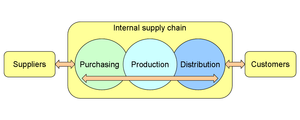A supply chain is a system of organizations, people, technology, activities, information and resources involved in moving a product or service from supplier to customer. Supply chain activities transform natural resources, raw materials and components into a finished product that is delivered to the end customer. In sophisticated supply chain systems, used products may re-enter the supply chain at any point where residual value is recyclable. Supply chains link value chains.[1]
A typical supply chain begins with ecological and biological regulation of natural resources, followed by the human extraction of raw material, and includes several production links (e.g., component construction, assembly, and merging) before moving on to several layers of storage facilities of ever-decreasing size and ever more remote geographical locations, and finally reaching the consumer.
Many of the exchanges encountered in the supply chain will therefore be between different companies that will seek to maximize their revenue within their sphere of interest, but may have little or no knowledge or interest in the remaining players in the supply chain. More recently, the loosely coupled, self-organizing network of businesses that cooperates to provide product and service offerings has been called
No comments:
Post a Comment